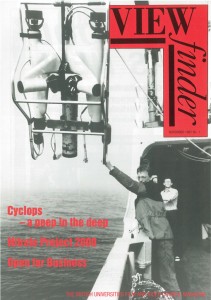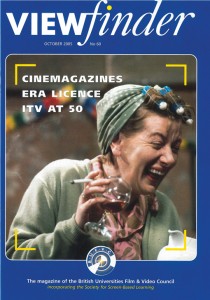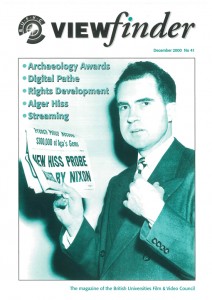To celebrate the publication of the 100th issue of Viewfinder, the BUFVC’s quarterly print publication, Olwen Terris, the BUFVC’s Information Officer, takes a look at the long history of the publication.
 About the Author: Olwen Terris is the BUFVC Information and Special Resources Officer. From 2005 to 2008 she was the Senior Researcher on the BUFVC Shakespeare database project. She was formerly Chief Cataloguer at the National Film and Television Archive, London. Olwen is co-editor, with Luke McKernan, of Walking Shadows: Shakespeare in the National Film and Television Archive (1994) and, with Luke, programmed the complementary year-long season of Shakespeare on film and television at the National Film Theatre, London (1994-95). Before joining the NFTVA, Olwen worked for the BUFVC as Assistant Information Officer and then Database Manager. Olwen is co-editor, with Eve-Marie Oesterlen and Luke McKernan, of the BUFVC’s Shakespeare of Film, Television and Radio: The Researcher’s Guide (2009).
About the Author: Olwen Terris is the BUFVC Information and Special Resources Officer. From 2005 to 2008 she was the Senior Researcher on the BUFVC Shakespeare database project. She was formerly Chief Cataloguer at the National Film and Television Archive, London. Olwen is co-editor, with Luke McKernan, of Walking Shadows: Shakespeare in the National Film and Television Archive (1994) and, with Luke, programmed the complementary year-long season of Shakespeare on film and television at the National Film Theatre, London (1994-95). Before joining the NFTVA, Olwen worked for the BUFVC as Assistant Information Officer and then Database Manager. Olwen is co-editor, with Eve-Marie Oesterlen and Luke McKernan, of the BUFVC’s Shakespeare of Film, Television and Radio: The Researcher’s Guide (2009).
The British Universities Film Council (BUFC) was formed in 1948 and from the beginning the imperative to communicate with its members and share knowledge and experience was established. Viewfinder began its life as the BUFC Bulletin in March 1950. 1,000 copies were printed at a cost of £30; the cover price was sixpence. Interestingly the issues and concerns which are found in the pages of the Bulletin, edited by Professor J.W. Tibble from the Department of Education, Leicester University, have changed very little from the themes, debates and concerns of Viewfinder today. In the 1950s the need to tell members about developments in educational technology, document and evaluate new films to support teaching, review books, and report on conferences at home and abroad was keenly felt. Media initiatives (although it wasn’t referred to as media then) from member universities were promoted, copyright legislation was explained, new publications were reviewed, and lists of films suitable for higher education teaching which had been researched, appraised and catalogued were distributed.
In spring 1953, the Bulletin became The University Film Journal. Its coverage continued to be wide-ranging and stimulating – early issues contained articles on the effect of musical accompaniment in film, Professor Eric Lucey’s filmed experiments in animal genetics, and stereoscopic experiments in teaching mathematics. In Professor Tibble’s final editorial from the spring 1964 issue, BUFC is encouraged to look to the young for new ideas:
‘The film is a young medium and the impetus for its development has come largely from young minds … it would be wise for BUFC to scrutinise its own average age and to be continually on the lookout for younger recruits.’
In December 1967, The University Film Journal became the BUFC Newsletter. BUFC had by now established a permanent office with full time staff in Old Compton Street in London’s West End and was able to draw on the extensive research and library facilities of the British Film Institute to support its own information work. Its concerns remained constant, presenting member news, compiling subject film listings, all communicated in a brisk, factual manner; there were no illustrations.
November 1979 (issue 38), edited by the Council’s new Assistant Director, Murray Weston, saw a welcome and overdue boost to presentation and production values – illustrations appeared; an arresting front cover (a giant aphid) was designed with clear indication on the cover of the content to be found within. That issue, almost thirty years on from the first Bulletin, continued in promoting the Council’s unwavering aims. Never insular, it featured an article on audio-visual provision in Swedish universities, a world AV programme directory, and sponsored productions by undergraduate media students at Rusden State College in Melbourne; there was a review of slide sets in archaeology and lengthy appraisals of films including First Signs of Washoe (1974), Protoplasmic Streaming (1977) and Some of the Palestinians (1976). The BUFC Newsletter became the British Universities Film & Video Council Newsletter in May 1983 (issue 49) to reflect the Council’s change of name.
The first issue of Viewfinder (Murray Weston remained the editor) was published in November 1987. Interestingly it described itself as a ‘magazine’, something more friendly, browseable and (crucially) illustrated, distancing itself from the more formal and academic presentations of the Bulletin and Journal. Typically, it arrived with minimum fuss - the BUFVC News section read:
‘This is the first issue of the Viewfinder magazine … It carries essentially the same information as the former BUFVC Newsletter but the intention is to include longer articles and reviews’.
 It was twenty-four pages long, printed in four columns (two for articles), and for the first time the cover was in duotone; it featured Cyclops, the remotely-operated vehicle being used by the BBC Natural History Unit in the Arctic Sea to record broadcast pictures at depths of over 100 metres. Articles included historian Jerry Kuehl writing about the Nitrate 2000 project, Sheila Innes, Chief Executive of the new Open College, giving an account of the problems of setting up the College and the task ahead, and a report on the newly-established British Video History Trust.
It was twenty-four pages long, printed in four columns (two for articles), and for the first time the cover was in duotone; it featured Cyclops, the remotely-operated vehicle being used by the BBC Natural History Unit in the Arctic Sea to record broadcast pictures at depths of over 100 metres. Articles included historian Jerry Kuehl writing about the Nitrate 2000 project, Sheila Innes, Chief Executive of the new Open College, giving an account of the problems of setting up the College and the task ahead, and a report on the newly-established British Video History Trust.
In November 2000 (issue 40) a new supplement Media Online Focus was introduced which carried information on moving images and related content delivered online, including databases and streamed media. The section was printed as a Viewfinder pull-out and linked to the sections of the website representing the new Managing Agent and Advisory Service (MAAS); this supplement ran for nineteen issues, ending in 2010 (issue 79).
Full colour came to Viewfinder in October 2005 (issue 60), edited by Jo Yates. The splendid cover depicts Jean Alexander as Hilda Ogden in Coronation Street complete with glass of wine, fag, headscarf and rollers – a far cultural cry from the magnified aphid of the first issue. Colour was put to effective use in reproducing stills from Pathe Pictorial to illustrate an article on the ‘Cinemagazines and the Projection of Britain’ project undertaken by the BUFVC and funded by the Arts and Humanities Research Council.
Looking through the long subject index the range of topics covered is fascinating – the Glasgow Labour Movement, Independent Local Radio, Russian cinema, Bioethics. A particularly interesting and revealing section, promoted by the current editor, Sergio Angelini, is ‘Profiles’, a page devoted to commemorating men and women who have made a great and long-lasting impact in careers which complement the Council’s aims - film theorist and filmmaker Laura Mulvey, Lucien Bull, innovator in the field of chronophotography and Val Gielgud, radio producer and author.
 All issues up to 2010 have been indexed and a browse through them (better still, the issues themselves) gives a fascinating history not only of BUFVC’s growth and development from its conception, but a history of educational technology, teaching methods, and audiovisual distribution over 65 years. The early issues spoke of 16mm films, slide sets and film loops; the latest issues of digital streaming, virtual technologies, off-air broadcast television and podcasts. Nevertheless, whatever the medium the message of promoting sound and vision, and informing members on how that might best be researched and delivered for effective learning, remains unchanged. The medium of disseminating the information did expand however in November 2011 when selected articles and reviews from Viewfinder started being published online on the BUFVC’s website (http://bufvc.ac.uk/viewfinder).
All issues up to 2010 have been indexed and a browse through them (better still, the issues themselves) gives a fascinating history not only of BUFVC’s growth and development from its conception, but a history of educational technology, teaching methods, and audiovisual distribution over 65 years. The early issues spoke of 16mm films, slide sets and film loops; the latest issues of digital streaming, virtual technologies, off-air broadcast television and podcasts. Nevertheless, whatever the medium the message of promoting sound and vision, and informing members on how that might best be researched and delivered for effective learning, remains unchanged. The medium of disseminating the information did expand however in November 2011 when selected articles and reviews from Viewfinder started being published online on the BUFVC’s website (http://bufvc.ac.uk/viewfinder).
In the BUFC’s 5th Annual Report 1952-1953, G. Patrick Meredith, chair of the Publications Committee, wrote:
‘It is really important, both for the success of the Journal and for BUFC itself, that representatives of member institutions should feel a stake in this publication --- our capacity for thinking creatively about the film medium is second to none; but the capacity needs to be articulated, and the University Film Journal is the appropriate organ for such expression’.
Mr Meredith’s observations are just as true today. We hope that BUFVC members feel that they have a stake in Viewfinder and are encouraged to contribute their ideas, write reviews and tell us about their work. In return, BUFVC continues to offer expertise in promoting members’ research and innovations in media and education, reporting on the latest technological solutions to delivering the very best teaching material in sound and vision.
Olwen Terris BUFVC Information Officer
Email: olwen@bufvc.ac.uk
Special Thanks
Over the last 28 years, Viewfinder has been supported by the BUFVC’s Information Service, most especially through the expertise and assistance of Jim Ballantyne, Cathy Grant, Olwen Terris, Marilyn Sarmiento, Nick Hiley, Luke McKernan and Andrew Ormsby. Their enthusiasm, knowledge and eagle-eye has saved the blushes of many successive editors, including: Murray Weston, Nick Wray, Chris Dry, Roland Glover, Suren Rajeswaran, Martyn Glanville, Hetty Malcolm-Smith, Jo Yates and Sergio Angelini.